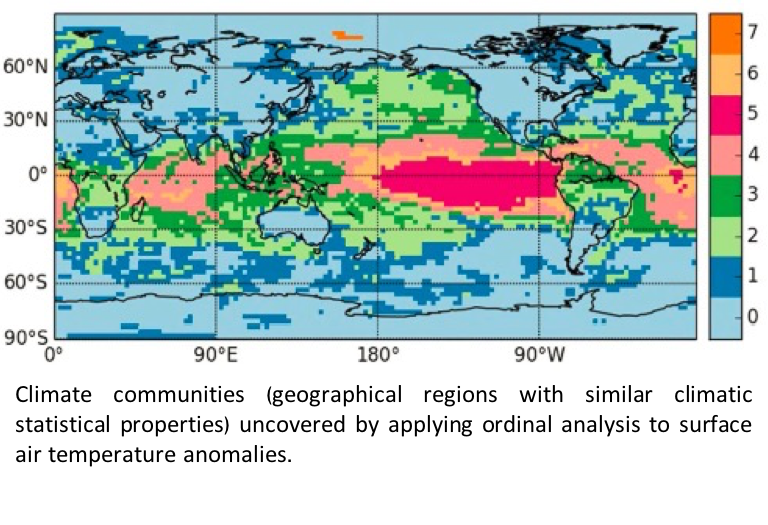Complex networks: fundamentals and applications

Many real-world systems, constituted by nonlinear interacting units, are modelled by complex networks (or graphs) in which the nodes represent the units and the links represent the interactions among them. These interactions are often only partially known, and we are interested in developing appropriated tools for inferring the network structure, from observed data. Typically, only limited (and noisy) data is available. We are also interested in extracting additional information about underlying phenomena, from observed data (for the identification of regime transitions, for uncovering the community structure of highly inter-related nodes, etc).
We apply advanced data analysis tools to two types of empirical data:
- Climatological time-series: we use the network approach and various data analysis tools (ordinal analysis, Hilbert analysis) to investigate long-range climatic interactions (inferring the underlying “climate network”) and signatures of regime transitions that can be related to “climate change”.
- Biomedical images: we use symbolic analysis (2D extension of ordinal analysis) and the network approach (by mapping a 2D image into a graph) to develop novel tools for image classification. We analyze ocular images with the goal of providing new measures for automatic/unsupervised classification. We also aim at providing reliable early-warning indicators of ocular diseases such as glaucoma.
Key words: complexity measures, permutation entropy, complex networks, climate networks, community structure, network inference, time-series analysis, symbolic analysis, ordinal analysis, Hilbert analysis, information theory, mutual information, Granger causality, directionality measures, transfer entropy, climate data analysis, tipping points and early warning indicators, image segmentation and signal classification tools.
Involved Researchers: C. Masoller
PhD Students: D. Zappala, P. Amil
Associated projects

LINC: Marie Curie Initial Training Network (ITN) Learning about Interacting Networks in Climate. LINC finished in 2015. The main goal of LINC was to train 15 researchers (12 PhD students and 3 postdocs) in the complete set of skills required to undertake a successful career in physics and geosciences with expertise in climatology, networks and complex systems. The results of the LINC project can be found in the European Commission web page and in the project web page climatelinc.eu.
Scientific coordinator: C. Masoller
Funding Agency: Commission of European Communities. FP7.
Partners:Potsdam Institute for Climate Impact Research; Bar Ilan University; Utrecht University; Universidad de la Republica, Instituto de Física Interdisciplinar y Sistemas Complejos; Ambrosys; Climate Risk Analysis; VORtech.
Project ref. No.: FP7-289447
Start/Ends dates: 1/12/2011-30/11/2015.

BE-OPTICAL: Advanced biomedical imaging and data analysis. BE-OPTICAL is a European training network that provides a structured training program to 14 PhD students in a wide range of optical imaging technologies and signal processing tools. Two PhD students in the DONLL group are working in (i) the development of incoherent light sources for speckle reduction in ocular imaging and (ii) the development of novel tools for the characterization and classification of biomedical images, with focus on ocular images. beoptical.eu.
Scientific coordinator: C. Masoller
Funding Agency: Commission of European Communities. H2020.
Partners: Georg-August-Universitaet Göttingen Stiftung; Uniwersytet Mikolja Kopernika W Toruniu; Max Planck Gesellschaft zur Foerderung der Wissenschaften; Institut de Microcirurgia ocular dos; PicoQuant Innovations GMBH; University of Saint Andrews; University of Glasgow; Centre National de la Recherche Scientifique
Project ref. No.: H2020-675512
Start/Ends dates: 01/10/2015 - 30/09/2019.

ICREA Academia. The aim of this project is (i) to exploit nonlinear dynamics and stochastic phenomena for novel applications and (ii) to develop advanced data analysis tools for studying the output signals of complex systems. A specific research objective is aimed at exploiting the optical spikes emitted by a semiconductor laser with optical feedback or injection, for implementing photonic neurons that mimic biological ones, but operate in times scales that are several orders of magnitude faster.
Scientific coordinator: Masoller, C.
Funding Agency: Institució Catalana de Recerca i Estudis Avançats.
Project No: ICREA ACADEMIA 2015-04.
Start/Ends dates: 01/01/2016 - 31/12/2020
Sistemas dinámicos complejos y herramientas avanzadas de análisis de datos.
This project studies nonlinear and stochastic phenomena in a broad class of systems including information processing by optical networks, extreme events in complex systems, neuronal excitability and brain dynamics, among many others.
Scientific coordinator: C. Masoller.
Funding Agency: Agencia estatal de investigación.
Participants: A. J. Pons.
Project ref. No.: PGC2018-099443-B-I00.
Start/Ends dates: 01/01/2019 - 31/12/2021.
Share: